Shuttle-Mir Team Members (S - Z)
Go
to
Team
Members
Group (A - B)
Go
to
Team
Members
Group (C - D)
Go
to
Team
Members
Group (E - G)
Go
to
Team
Members
Group (H - K)
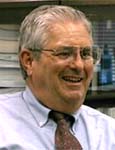 George
W. Sandars Profile
George
W. Sandars Profile
George Sandars of NASA Johnson Space Center was co-chair for the Flight Operations and Systems Integration Working Group. This group developed the flight programs and crew work schedules for Phase 1. The group also devised the requirements for control, communications, and systems integration.
"Our particular group is called Working Group 3," said Sandars, in his Oral History, "and it's a combination of the operations, MOD [Mission Operations Directorate], and the engineering, or integration, payload integration world, or systems integration. We do the engineering functions: the loads, stresses, thermals, flight control, water transfer, ECLSS [Environmental Control and Life Support Systems], all the various technical areas. We interface with the Russians and have those discussions and define the technical requirements environments required for both people to certify to, to end up and say that we can go fly these particular missions."
Anthony C. Sang Profile
Tony Sang was NASA's Operations Lead (Ops Lead) in Russia for the Linenger Increment, coordinating communications between Mir astronaut Jerry Linenger, NASA, and Russia from the Russian Mission Control Center.
In the Ops Lead role, Sang was in charge of the Mir Operations Support Team for Increment 4, managing a group that included a mission science representative, a biomedical engineer, a payloads systems engineer, an operations support tech, a flight surgeon, and a public affairs representative.
While serving in the capacity of Ops Lead, a fire occurred aboard the Russian Space Station Mir. In his Oral History, Sang described how he learned about the incident:
"I didn't hear about the fire until the next morning. We got in approximately [to the TsUP], I guess, 9 o'clock, and I had a ground [comm] pass that was dedicated to me in a few minutes, like in 10, 15 minutes. So as usual, I look at my notes and make sure there's anything I need to pass up to him, any questions, I need to pass up to Jerry [Linenger].
"So I go down to the control room, the front room, and I looked around and I noticed there were a lot of people there, more than usual. A lot of them I recognized because I worked in the ECLSS [Environmental Control and Life Support Systems] group before and I met all the ECLSS players on the Russian side . . .
"They had their big boss there, whose name is Eduard Grigorev, who has since passed away. He recognized me, too, and a lot of the other Russian life-support guys recognized me. Mr. Solovyev, the lead flight director, came up to me, in his broken English saying, 'We have a little problem.'
"But right then, ground [comm] pass is about to start, so I put on my headset and I listen. I told him, 'Well, if there was a problem,' and evidently it was a life-support program, 'then you can have the comm.' So I started listening and I recognized the word for 'fire.' Right then I went, 'Oh, no.'"
Prior to Ops Lead role, Sang worked in NASA's Mission Operations Directorate in the environmental control life support area before serving on the Mir Extension Assessment Team.
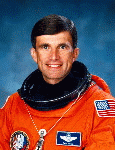 Ronald
M. Sega Profile
Ronald
M. Sega Profile
NASA Astronaut Ron Sega served as a Director of Operations (DOR) in Russia during Phase 1. As a DOR, he was responsible for the coordination and implementation of Phase 1 mission operations activities between Russia and NASA, managing a vital support systems office in Star City, Russia.
Sega became an astronaut in 1991, and he flew on the shuttle twice as a mission specialist. Prior to his NASA career, Sega was a pilot in the United States Air Force, and he was also on the faculty of the U.S. Air Force Academy in the Department of Physics. Sega holds a Bachelor of Science degree in mathematics and physics from the U.S. Air Force Academy, a Master of Science degree in physics from Ohio State University, and a Doctorate in electrical engineering from the University of Colorado.
In his Oral History, Sega said: "I believe we have learned a great deal in Phase 1 for joint efforts in space with the Russians, as well as long-duration flight, the principal contributions to that learning probably in the operation side, whether it be doing rendezvous and docking or communications with those on the ground and scheduling of experiments, to some of operations of the equipment on board."
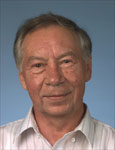 Vladimir
Semyachkin Profile
Vladimir
Semyachkin Profile
Vladimir Semyachkin, the general designer for RSC Energia, was responsible for the development of motion control systems and navigation systems for all vehicles and stations that have been developed and are launched into space by Energia. Semyachkin was involved in the early discussions of the joint venture and his participation was continual throughout the Phase 1 Program.
One of the earliest areas addressed by Semyachkin and his colleagues was how to allow the American Shuttle vehicle to dock to the station, taking into account the capabilities of the motion control system on the Mir.
"Many things had to be clarified to the nth degree of detail. We had to understand, for example, the coordinate system used aboard the Shuttle and work out the correspondence between it and the system coordinates used aboard the Mir station. We had to also be able to determine the motion parameters, the values for those parameters, that would allow the Shuttle to dock to the Mir station, a very interesting and very stressful talk," he said in his Oral History.
He also commented on the physical effects the Shuttle exerted on Mir during the approach phase: "[D]uring the Shuttle's approach to a docking port, its jets affect the motion of the Mir. So we, together with our American colleagues, set about solving the problem, and this involved them releasing to us, for example, data including the time line of the jet activations that would be employed during the final phase of the approach. We, on the other hand, have to take this data, and then to perform an assessment we did models for modeling in order to determine how seriously the use of the jets would affect the control of the motion of the Mir station. Thanks to excellent cooperation on both sides, all of these issues were successfully addressed, documents and reports on the modeling were issued, and all of the conclusions that were derived on the ground were confirmed by actual operations on orbit."
Vladimir A. Solovyev Profile
Vladimir Solovyev of RSC Energia was the co-chair for the Flight Operations and Systems Integration Working Group. This group developed Phase 1's flight programs and crew work schedules. The group also devised the requirements for control, communications, and systems integration.
Additionally, Solovyev served as the lead Mir flight director, and he is a former cosmonaut who has logged over 350 days in space. On his 1986 flight, Solovyev and his crewmate flew to both the Mir and the Salyut-7 space stations, making them the only crew in history to visit two space stations in a single spacecraft.
In his Oral History, Donald Noah, NASA's lead in charge of all shuttle integration for STS-74, commented on Solovyev: "He was an ex-cosmonaut, a national hero of the Soviet Union, all the medals and stuff. Wonderful guy, really a nice guy, sharp, one of the sharpest guys they had. I mean, he was certainly an asset to that program."
Boris I. Sotnikov Profile
Boris Sotnikov from RSC Energia was co-chair for the Joint Safety Assurance Working Group. This group was responsible for evaluating the safety requirements of the Shuttle-Mir Program. The group also analyzed off-nominal situations and reviewed cargo safety.
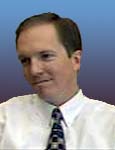 Charles
Stegemoeller Profile
Charles
Stegemoeller Profile
Charlie Stegemoeller was NASA's project manager for the Mir Spektr module, which carried scientific equipment to Mir for the U.S. residents. In accomplishing this task, Stegemoeller worked with American and Russian colleagues to determine the equipment appropriate for Spektr and its location within the module. During the activation of Spektr in May 1995, he served as the "capcom" in the Russian Mission Control Center.
As project manager for the Mir Spektr module, Stegemoeller traveled many times between the NASA Johnson Space Center in Houston, Texas, and Russia. Because these trips occurred during the early days of the Shuttle-Mir Program, he encountered numerous challenges, especially when shipping materials to Moscow.
Stegemoeller also learned about cultural differences in technology while in a session with his Russian counterparts on the Spektr team. (From Stegemoeller's Oral History):
"You know those white boards? Press the button and it prints out the white board?
"We had just spent, I don't know, several hours, if not a day, talking about allocations. We counted up just the right - we counted up and we finally said, 'All right, let's put it on the board.' We wrote it on the board and got everybody to agree. The Russians understood the translator. We understood the translator. We said, 'Everything's right, da?' 'Da.'
"So we hit the 'print' button and the Russians just went - they sat back in their chair. One of them, Nikolai goes, 'Ah, America!' Because of this high technology, just printing out what we had written on the board.
"We had a good relationship from then on. It was always a challenge, though," said Stegemoeller.
After his Spektr assignment was complete, Stegemoeller worked with the Mir Operations Integration Working Group. This group coordinated the hardware integration and operations activities of NASA hardware that flew aboard Russian vehicles.
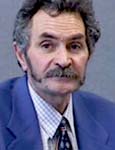 Oleg
Tsygankov Profile
Oleg
Tsygankov Profile
Oleg Tsygankov served as the manager of the Mir EVA (extravehicular activity) office, which is responsible for EVA technical support and Mir maintenance. Tsygankov attended Kiev's Technological Institute. He received a Ph.D. in engineering from Moscow Aviation Institute and a doctorate from Kharkov Aviation Institute. He has worked for Energia since 1969.
In his Oral History, Tsygankov compared the Russian Orlan EVA suit with NASA's spacesuit: "[During our years] of our mutual work with NASA, we've studied, we've learned a great deal about different capabilities of Orlan and EMU [Extravehicular Mobility Unit]. Something is better in one spacesuit, something is better in another spacesuit, but from a standpoint of functionality, I would say they're both equivalent. Orlan would allow a person as high as 185 centimeters-it's about six feet, two inches-to walk into ità.
"Orlan is like a monostructure. Of course, there are some disadvantages in this concept, but there are advantages as well. A person can get into Orlan without anybody's assistance relatively quickly. You open the door from the back like a refrigerator, you walk into the spacesuit and close it. Then you're ready to do a spacewalk. Those are the special features of the Orlan."
Valeri A. Udaloy Profile
Valeri Udaloy was the MCC-M co-chair for the Public Affairs Working Group. This group planned, coordinated, and implemented all public affairs activities.
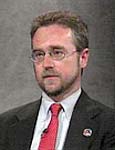 John
J. Uri Profile
John
J. Uri Profile
John Uri of NASA Johnson Space Center served as the co-chair for the Mission Science Working Group. This group developed Phase 1 scientific programs and experiments, and it defined the requirements for Shuttle-Mir science equipment.
Uri commented on the benefits from "a science perspective" of the Phase 1 Program (in his Oral History):
"Early in the program, before we started flying, there were people that didn't think Mir was a good enough environment to do some of the science. Turns out that was not the case. It's a very stable environment for doing the microgravity type of experiments that require the minimal bumping and vibrations and so on. Turns out the results we got were excellent.
"So I'm not sure what people based that early belief on, but that proved to be not the case. We did more experiments overall in the whole program than we had anticipated, partly because of the extension. I think the results that are coming in now are very, very exciting, and there's, I think, a lot more to come."
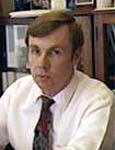 James
E. Van Laak Profile
James
E. Van Laak Profile
James Van Laak served as the Deputy Program Manager for NASA's Phase 1 Shuttle-Mir Program. He also was a member of the Management Working Group, where he helped to provide technical coordination of RSA and NASA Phase 1 activities.
Prior to his NASA career, Van Laak spent ten years in the Air Force as a pilot. In his Oral History, Van Laak said:
"On one occasion I was in Star City, which is where they train the cosmonauts, and I heard an airplane take off. It is a military base, basically. I looked out the window and a MiG-23 was taking off, which is an older Russian airplane, but it's one that was front line when I was in the Air Force, and one that I trained to fight against.
At that time it was clear that there was a real military element to this, that this was still the former Soviet Union, and that these people we were meeting with were twice and thrice heroes of the Soviet Union and so on, and yet they were flesh and blood people with their own concerns and their own families.
"One doesn't have to look very far in Russia - in fact, you can't escape the fact that their economic strength, the individuals, their economic well being is much less than ours, their standard of living and so on.
"So I think that insofar as the relations between the countries is built in large part on the feelings of the individual citizens of both countries, I think this [Phase 1] has been a watershed event. I know that many Russians were suspicious of us, probably jealous of us for our material wealth and those sorts of things. "I feel confident that a great many of them have come to understand that we just live in a different culture. We're still good people with sound moral values and so on, and that they can come to trust us as we have learned to trust them. So in the aggregate, I think it's been a wonderful thing."
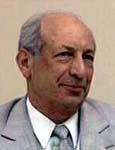 Pavel
M. Vorobiev Profile
Pavel
M. Vorobiev Profile
Pavel Vorobiev from the RSC Energia served as co-chair for the Cargo and Scheduling Subgroup, which was a division within the Management Working Group. This group was responsible for joint manifesting, cargo traffic scheduling, and cargo delivered by the shuttle to the Mir.
Vorobiev has worked for Energia since 1957 when he was hired by Sergei Korolev, the chief designer of the Soviet space program. Vorobiev worked on the Zond Project, which sent the first satellite to orbit the Moon.
Regarding the Phase 1 Program, Vorobiev said (in his Oral History) many of the experiences will prove to be valuable for the success of the International Space Station:
"Over the course of our work, we were able to develop a whole technique of loading cargo into the orbiter based on the needs of the station. We were able to achieve a certain flexibility which was also never practiced before. For example, whenever we need to load something that is urgent for the station or maybe such cargo as food items or something that is required in case of sudden contingency, we now are capable of doing these things.
"So now we're going to use this valuable experience during the next phase, Phase 2 of the space station, and I think that was the main result of work for the last few years."
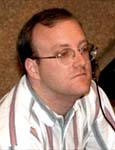 Keith
E. Zimmerman Profile
Keith
E. Zimmerman Profile
Keith Zimmerman was NASA's Operations Lead (Ops Lead) in Russia during the Foale Increment. His duties included coordinating communications between Mir astronaut Michael Foale, NASA, and Russia from the TsUP, the Russian Mission Control Center. In this role, Zimmerman was in charge of the Mir Operations Support Team for Increment 5, managing a group that included a mission science representative, a biomedical engineer, a payloads systems engineer, an operations support tech, a flight surgeon, and a public affairs representative.
Six weeks into the Foale's increment, a Progress resupply ship rammed into Spektr, one of Mir's six modules. The collision on June 25, 1997, caused a loss of pressure aboard the Russian Space Station. In his Oral History, Zimmerman described the TsUP during this crisis situation:
"Within about five minutes, I guess, the word got out pretty quick, and people just started pouring into the control room. The senior flight director, Vladimir Solovyev, was actually over in the Progress control room, since that's the dynamic vehicle, it was the one doing the moving.
"But he's the senior flight director for the whole control center, actually, so he outranks everybody. Actually, once the collision happened, within a couple of minutes he took over running both control centers, and he just started issuing orders, 'Okay, you guys do this, you guys do this. Commander, go do this. Mike, do this,' and just real strict about 'Do this, do this, do this.' I mean, that helped a lot.
"They had to get the Soyuz ready in case the crew had to leave and abandon ship, that was one possibility, but you also wanted someone to try to figure out where the leak was and close that module if you could. He [Solovyev] did a good job of trying to direct the right people in the right way."
Zimmerman began his career at NASA in the shuttle's pointing office, determining the rotational orientation of objects and pointing various instruments at targets. Later, he became the lead pointing engineer for the Space Station program before moving into the position of Ops Lead.
Go
to Team Members group (A - B)
Go
to Team Members group (C - D)
Go
to Team Members group (E - G)
Go
to Team Members group (H - K)